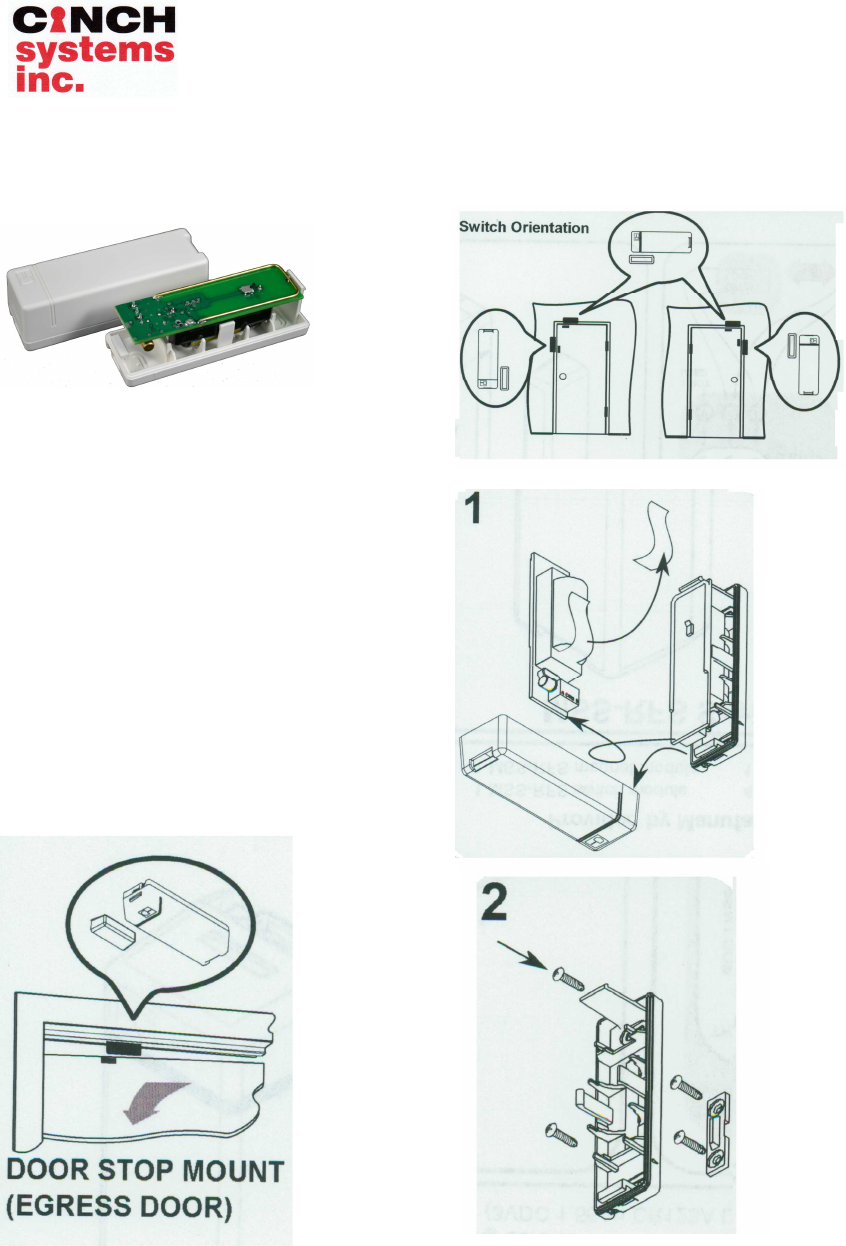C H Systems RF-SDWS Door/window sensor used by Security System User Manual I RF SDWS Rev A Installation Manualupd
Cinch Systems, Inc Door/window sensor used by Security System I RF SDWS Rev A Installation Manualupd
Contents
- 1. User Manual
- 2. User Manual II
- 3. User Manual III
User Manual II

Secure ◄► Simple ◄► State of the Art
Installation Instructions
Document Number: I-RF-SDWS Rev. A
March 2104
RF-SWDS Wireless Door/Window Sensor
Rev A CINCH Systems, Inc. Page 1 of 3
Part #: RF-SDWS-MAG (Wireless
Door/Window Sensor)
Product Summary
The Wireless Door/Window Sensor is compatible
with all Interlogix wireless control panels. The
device is surface mounted and equipped with an
internal contact and the capability of using an
external contact. A cover tamper doubles as an
enrollment switch.
Installation:
The sensor is designed to mount on the door or
window frame and the magnet on the door or
window (moving part).

Secure ◄► Simple ◄► State of the Art
Installation Instructions
Document Number: I-RF-SDWS Rev. A
March 2104
RF-SWDS Wireless Door/Window Sensor
Rev A CINCH Systems, Inc. Page 2 of 3
Wiring:
Programming:
See control panel installation instructions for
programming references.
Specifications:
Battery: 3VDC, 1.55Ah,
CR123A Lithium Battery
Typical Battery Life: Up to 14+ Years
External Input Sampling
Current: 20 µA
Switch Type: Reed
Operating Gap: 0.63 in (1.60 cm)
Magnet Type: Neodymium
Iron Boron (Rare Earth)
Supervisory Interval:
64 minutes
Wire Run to External Input:
100 feet (30.5 m)
Operating Temperature:
14°F (-10°C) to 140°F (60°C)
Enclosure: ABS POLYLAC® PA-717C
(UL94 HB flame-rating)
Weight: 1.6 oz. (51g)
Switch Dimensions: 3.2 in
(81.3 mm) L x 1.04 in (26.4 mm)
W x .96 in (24.4 mm) H
Magnet Dimensions: 1.3 in
(33 mm) L x 0.5 in (1.27
mm) H x 0.43 in (10.9 mm) W
Color: White or Brown

Secure ◄► Simple ◄► State of the Art
Installation Instructions
Document Number: I-RF-SDWS Rev. A
March 2104
RF-SWDS Wireless Door/Window Sensor
Rev A CINCH Systems, Inc. Page 3 of 3
FCC:
FCC label statement:
“This device complies with part 15 of the FCC
Rules. Operation is subject to the following two
conditions: (1) This device may not cause harmful
interference, and (2) this device must accept any
interference received, including interference that
may cause undesired operation.”
“Note: This equipment has been tested and found
to comply with the limits for a Class B digital
device, pursuant to part 15 of the FCC Rules.
These limits are designed to provide reasonable
protection against harmful interference in a
residential installation. This equipment generates,
uses and can radiate radio frequency energy and, if
not installed and used in accordance with the
instructions, may cause harmful interference to
radio communications. However, there is no
guarantee that interference will not occur in a
particular installation. If this equipment does cause
harmful interference to radio or television
reception, which can be determined by turning the
equipment off and on, the user is encouraged to try
to correct the interference by one or more of the
following measures:
—Reorient or relocate the receiving antenna.
—Increase the separation between the equipment
and receiver.
—Connect the equipment into an outlet on a circuit
different from that to which the receiver is
connected.
—Consult the dealer or an experienced radio/TV
technician for help.”
“Changes or modifications not expressly approved
by the party responsible for compliance could void
the user's authority to operate the equipment”
“RF Exposure Guidance: This equipment
complies with FCC radiation exposure limits set
forth for an uncontrolled environment. This
equipment should be installed and operated with a
minimum distance of 1.5cm between the radiator
and persons. This transmitter must not be co-
located or operating in conjunction with any other
antenna or transmitter, except in accordance with
FCC multi-transmitter product procedures.”
I.C.:
I.C. label Statement:
IC: 11817A-RFSDWS
“This device complies with Industry Canada
licence-exempt RSS standard(s). Operation is
subject to the following two conditions: (1) this
device may not cause interference, and (2) this
device must accept any interference, including
interference that may cause undesired operation
of the device.
Le présent appareil est conforme aux CNR
d'Industrie Canada applicables aux appareils
radio exempts de licence. L'exploitation est
autorisée aux deux conditions suivantes : (1)
l'appareil ne doit pas produire de brouillage, et
(2) l'utilisateur de l'appareil doit accepter tout
brouillage radioélectrique subi, même si le
brouillage est susceptible d'en compromettre le
fonctionnement. »
Under Industry Canada regulations, this radio
transmitter may only operate using an antenna of
a type and maximum (or lesser) gain approved for
the transmitter by Industry Canada. To reduce
potential radio interference to other users, the
antenna type and its gain should be so chosen that
the equivalent isotropically radiated power
(e.i.r.p.) is not more than that necessary for
successful communication.
Conformément à la réglementation d'Industrie
Canada, le présent émetteur radio peut
fonctionner avec une antenne d'un type et d'un
gain maximal (ou inférieur) approuvé pour
l'émetteur par Industrie Canada. Dans le but de
réduire les risques de brouillage radioélectrique à
l'intention des autres utilisateurs, il faut choisir le
type d'antenne et son gain de sorte que la
puissance isotrope rayonnée équivalente (p.i.r.e.)
ne dépasse pas l'intensité nécessaire à
l'établissement d'une communication
satisfaisante.